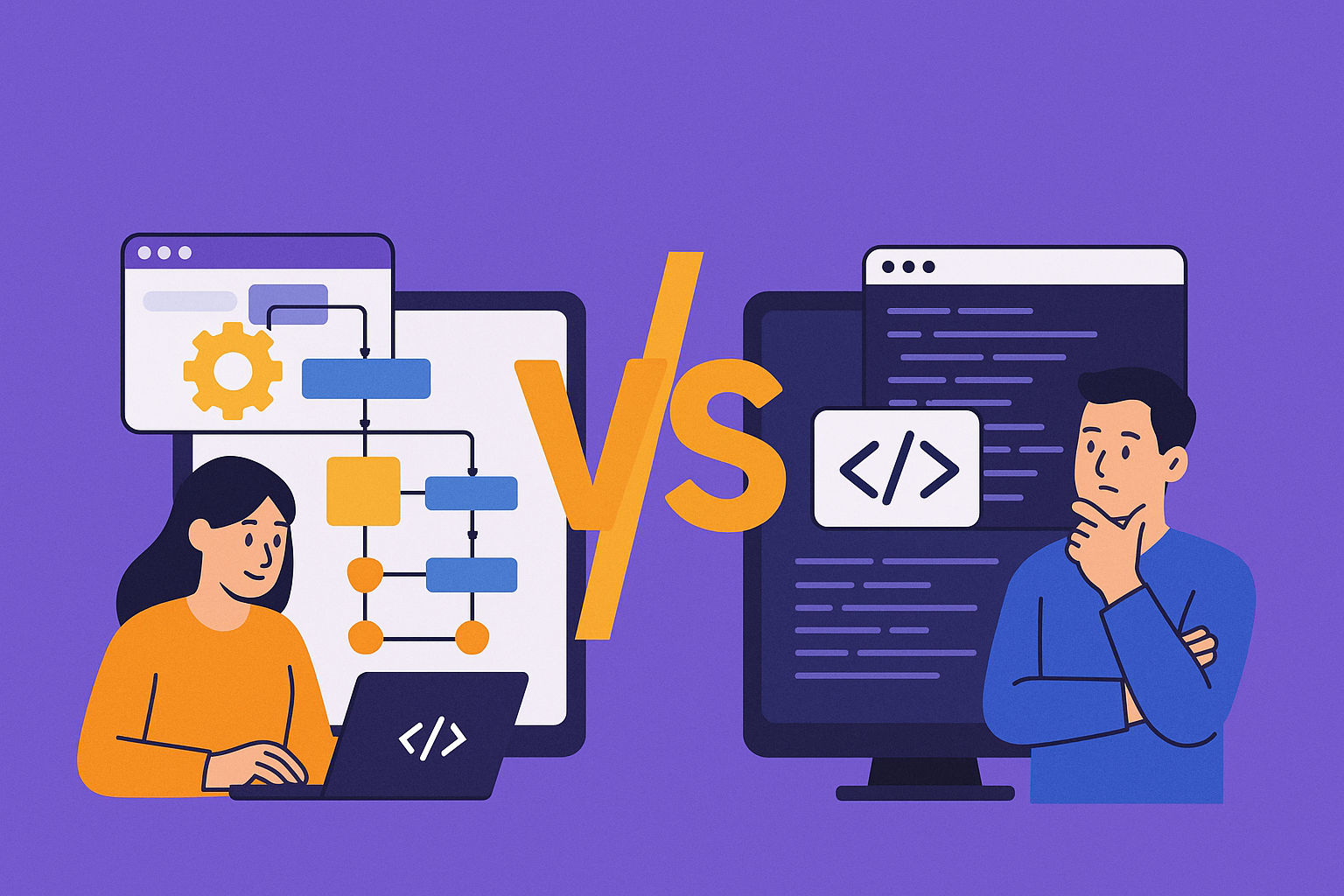- Our Work
-
-
PORTFOLIO
OTHERS
-
-
- Services
-
- How We Work
-
- Resources
-
- About Us
-
- Contact Us
- Let’s Talk
In recent years, the explosion of no-code and low-code platforms has changed the way businesses build software. From startups wanting to validate ideas quickly, to enterprises digitizing processes without ballooning budgets, these tools have lowered barriers to entry.
But there’s a critical question for any organization or decision-maker:
Should you adopt no-code/low-code platforms—or invest in custom development?
At Finally Free Productions (FFP), we help clients evaluate this choice carefully. In this article, we’ll unpack the differences, advantages, limitations, and key factors to guide your decision.
What is No-Code/Low-Code?
No-code and low-code platforms enable building applications with minimal (or no) traditional coding.
No-code tools target non-developers entirely, offering drag-and-drop interfaces. Examples include Bubble, Webflow, Airtable, and Glide.
Low-code tools provide pre-built components but allow developers to extend functionality with code. Popular options are OutSystems, Mendix, and Microsoft Power Apps.
These tools promise speed, cost-efficiency, and accessibility. But are they right for every project?
Benefits of No-Code/Low-Code
✅ Faster Time to Market
Launch MVPs or internal tools in days or weeks instead of months.
✅ Lower Development Costs
Avoid the full cost of a custom development team.
✅ Empower Non-Technical Teams
Let operations, marketing, or business teams build what they need.
✅ Ease of Maintenance
Vendors manage infrastructure, hosting, and updates.
Limitations of No-Code/Low-Code
❌ Vendor Lock-In
You’re dependent on a platform’s roadmap, pricing, and limitations.
❌ Scalability Constraints
High-traffic, complex, or resource-intensive apps may hit performance ceilings.
❌ Limited Customization
Advanced integrations or unique business logic can be hard (or impossible).
❌ Security & Compliance Concerns
Regulated industries may face challenges around data control and auditability.
When Should You Choose No-Code/Low-Code?
No-code/low-code is ideal when:
⭐ Validating an MVP or prototype quickly
⭐ Automating internal workflows
⭐ Building lightweight apps for a defined user base
⭐ Reducing costs on simple features
⭐ Empowering non-dev teams for operational agility
When Should You Choose Custom Development?
Custom development is the better choice when:
🔒 Security and compliance are critical
📈 You expect high user traffic or growth
⚙️ You need highly unique functionality
🧩 Complex integrations with other systems are required
🔄 You want full control over the tech stack and roadmap
The Hybrid Approach
Many organizations now combine both:
➡️ Prototype in no-code to validate the idea.
➡️ Build custom once requirements stabilize or scale demands increase.
At FFP, we often help clients evaluate which path to start with—and when to switch.
We also help maintain hybrid stacks: using no-code for internal dashboards while building mission-critical customer-facing systems fully custom.
How Finally Free Productions Can Help
Choosing the right approach isn’t just technical—it’s strategic.
At Finally Free Productions, we guide clients through:
✅ Needs assessment
✅ ROI analysis
✅ Platform selection
✅ Custom software design & development
✅ Hybrid architecture planning
Our goal is to ensure you get the right solution for your budget, timeline, and long-term goals.
Final Thoughts
The rise of no-code and low-code platforms is one of the most exciting shifts in software development. But it’s not a one-size-fits-all answer.
By understanding the pros, cons, and use cases, you can make an informed choice that sets your project up for success.
Want help evaluating your options? Contact us today.
 All
All AI & ML
AI & ML Healthcare
Healthcare Education
Education Games
Games Fitness
Fitness Business
Business Webapps
Webapps Websites
Websites More
More Startup
Startup Web3 Development
Web3 Development Capabilities
Capabilities Game Development
Game Development Website Development
Website Development Prototyping Services
Prototyping Services Mobile App Development
Mobile App Development Client Dashboard
Client Dashboard Design Process
Design Process IP Protection
IP Protection Project Management
Project Management Working with Finally Free
Working with Finally Free FAQ
FAQ How to Videos
How to Videos About FFP
About FFP Meet The Team
Meet The Team Press
Press